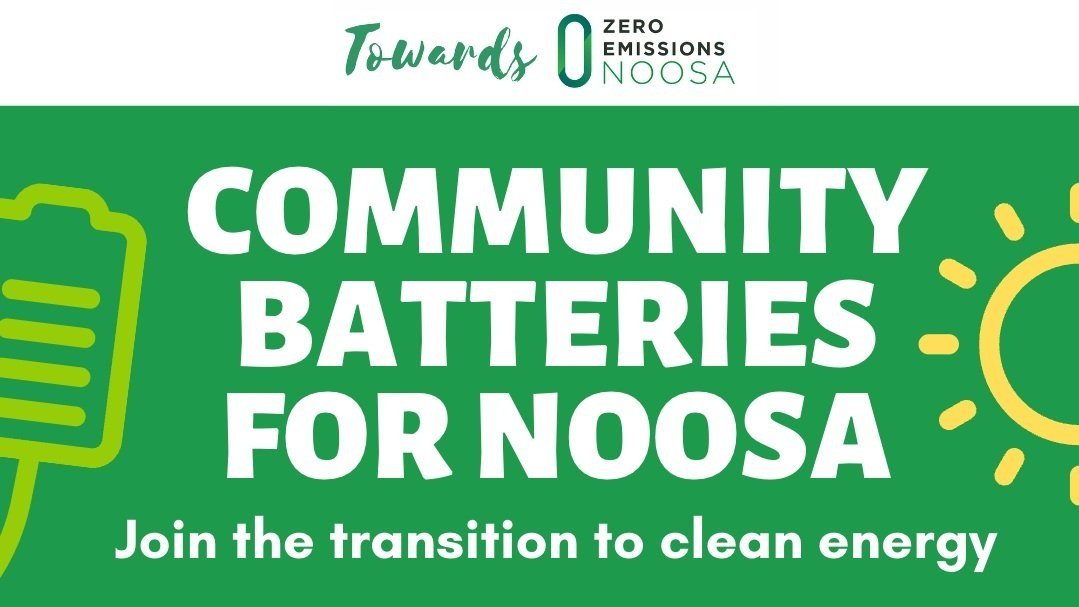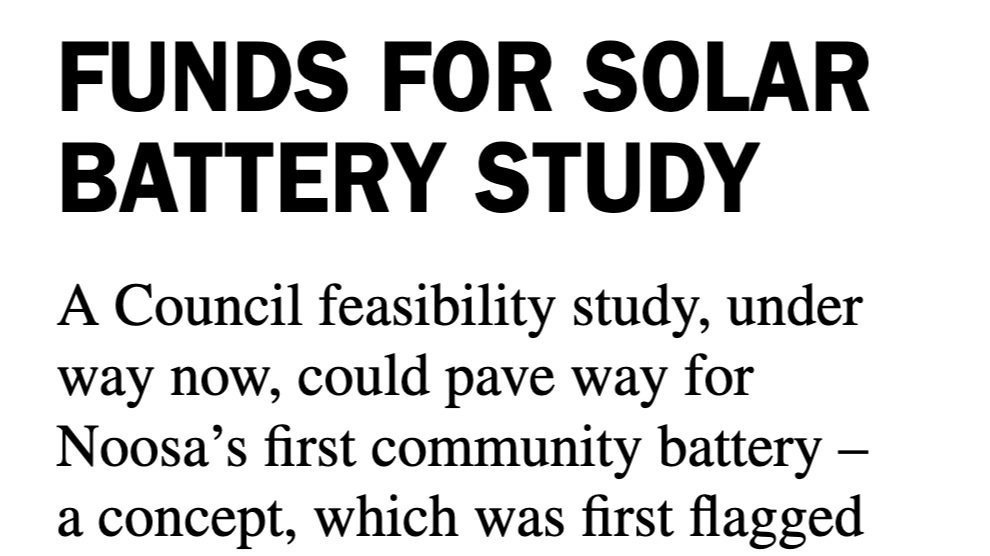Community Batteries Project
In late 2020, Zero Emissions Noosa starting researching Community / Neighbourhood batteries to help on the journey towards the goal of zero net community emissions by 2026. With Council funding we commissioned a report by experts to inform us, and a working group with strong credentials was formed in mid 2021. Follow this page to keep up to date with our progress.
These pages are a work-in-progress, and some of the content is at a draft stage.
“Why is Zero Emissions Noosa promoting community batteries for Noosa Local Government Area, how do they work and who will benefit?”
Why?
Rapid uptake in solar is causing ‘congestion’ in the electricity network, that is, more renewable energy than the grid can handle. Unfortunately, if renewable energy can’t be used, exported to the grid, or stored, it is wasted.
The electricity grid is now experiencing reverse power flows from consumer (solar PV) to distributor (solar export) which the grid was not designed for. To alleviate infrastructure upgrades to cope with this problem, a number of solutions are being explored. Community Batteries are one of them.
How?
Community batteries address this problem by absorbing and storing excess energy from rooftop solar (like a sponge) and releasing it during peak times when it is needed most.
Noosa is doing well with 45% of residential homes now having solar, with some hinterland areas with over 70%. If we are to reach ZEN’s goal of net zero emissions by 2026 we will need to achieve a massive growth in rooftop solar more than doubling the amount of rooftop solar installed, and the grid would not be able to handle this without changes.
Community Batteries are a middle level of storage, between the ever-increasing network- scale big batteries, and behind-the-meter home batteries (and in the future aggregated EV batteries in vehicle-to-grid (V2G)). They are a more affordable and cost-effective solution for renewable energy storage than individual household batteries, which are still too expensive for most people.
With community batteries, we can make our energy system more resilient, climate friendly, equitable, and affordable.
Who benefits?
Community Batteries deliver benefits to the entire community, whether residents have solar panels or not, providing greener and more equitable power supply.
They support decarbonisation and allow more renewables connect to the grid, seeing storage as an essential player in reducing grid congestion and supporting solar generation.
Community Batteries meet residents’ aspiration to make energy more local, and therewith provide local economic value, employ local people, and keep battery profits in the locality.
Community Batteries also appeal to those residents who want to ‘do their bit,’ contributing to reducing or shifting energy use and support the energy transition. This helps creating a sense of community, building community connections and sharing the benefits of local renewable energy to promote fairness.
Solar Generated Electricity is plentiful in the Noosa LGA
The graphs show why community batteries should be a good fit for Noosa
solar is growing at 1MW per month
the amount of solar exported is growing rapidly
there are days in some Zone Substation areas where solar generation exceeds what is consumed. At Cooran (Pomona) now at 240+ days a year
there’s a lot of excess solar at Cooran Zone substation that is exported out of Noosa, so would be great to store this during the day and release it at night
Video explainers
Our Objective
(from Grant Proposal)
The ZEN Inc community group and Noosa Council have received requests from community groups, businesses, bodies corporate, individuals and Councilors about the introduction of community batteries in the Noosa LGA. We have been investigating initiatives in other jurisdictions to assess their viability locally to support time shifting of excess generated solar PV, increased hosting capacity, whilst also providing network support particularly on LV feeders, all in a financially viable way.
To help meet the challenges of the energy transition and to meet zero emissions targets, we wish to collaborate with stakeholders, and especially Energex / Energy Queensland to explore and define areas of mutual benefit in this space.
Following from our commissioned roadmap report “Achieving 100% Renewable Electricity in Noosa”, it’s now time to plan how to best time shift the excess daytime solar electricity through a large number of strategically located batteries to support the Noosa community whilst providing support for our grid network.
“This new roadmap will be the “Business Plan for a Network of Community Batteries in the Noosa LGA”, and will guide the pathway to grow from a single community battery, to a dozen, and in time to more than 100.”
We expect that this specific plan for Noosa will be able to be easily adapted to other local government areas in South East Queensland in the Energex zone, and beyond.
Yarra Energy Foundation - North Fitzroy Community Battery - street view
YEF North Fitzroy Community Battery - rear view - “Set the controls to harness the sun”
How to bring Power to the People
The following has been extracted from this excellent article by the ANU Battery Storage and Grid Integration Program team. Read the full article here
“It’s about incorporating the values they see missing in the energy transition into the design of the business model and battery governance…..
….support decarbonisation and allow more renewables, seeing storage as an essential player in reducing grid congestion and supporting solar generation. Many people want to make energy more local, and are intuitively drawn to the potential to provide local economic value, employ local people, and keep battery profits in the locality.
People also want to know how they can ‘do their bit,’ contributing to reducing or shifting energy use to support the energy transition. In doing so, they want to create a sense of community, building community connections and sharing the benefits of local renewable energy to promote fairness.
Choices have to be made about what values the battery generates. It might be helpful for people to think about value balancing….
We can make sure at this early stage that we consider different ownership, business model and financing options, and evaluate these in terms of what benefits they deliver, and to whom. These benefits will influence the level of trust that people have in batteries, locally and generally.
Business models are central because they encode; 1) where the financial benefits flow; 2) how complex it is for householders to participate and 3) whether the battery fulfils decarbonisation objectives.”
Community Batteries Project News
Community Battery locations - DRAFT
TO DO - Leader about where to locate batteries
criteria
preliminary lists
express your interest
Follow our Journey - DRAFT
TO DO - Just some highlights go in here……
And the details and links go on another page
Community Battery Events - Draft
TO DO
Who is involved ? - Draft
TO DO
just summary here
link to page with people, roles.pics & bios
Submissions and Reports - draft
TO DO: Introduction words to come
Further Reading & Resources - Draft
TO DO: YEF resources are top notch !
Yarra Energy Foundation - Launch of First Community Battery
https://onestepoffthegrid.com.au/hugely-innovative-community-battery-launched-in-melbourne/
https://www.abc.net.au/news/2022-06-05/community-battery-in-melbourne-unveiled/101127080
TO DO: Leadin words to go here….
Data and Maps - Draft
TO DO: Data show relevant data about solar in Noosa, energy consumption, and the loading on the Zone Substations that service the electricity needs of the Noosa local government area.
We’ve include maps of the electricity network, and where some of the initial trial sites may be located.
Government Policies
Following the May 2022 Federal election, we assume the platform that the ALP took to the election will become government policy. Here’s an extract relating to “Community Batteries” from the document Powering Australia.
Refer to our Newsroom article which documented the commitment made by now Minister for Climate Change and Energy, Chris Bowen, for a $500k Community Battery for Noosaville.
“Community Batteries for Household Solar
One in four Australian households have already joined the rooftop solar revolution – because it’s cheap, reliable and curbs pollution.
Reforms like Labor’s Renewable Energy Target, that the Government tried to abolish – have helped to speed this along and get cheaper electricity in the hands of Australian families.
But with just 1 in 60 households having battery storage, there’s more to be done. Our plan will enable homes with solar to share the power they generate with other households.
“It’s a $200 million investment to cut power bills, cut emissions and reduce pressure on the electricity grid.
”
Increasing battery storage across the country is vital to taking full advantage of cheap solar energy. Community batteries are already being trialled in several locations. Labor’s support will accelerate the rollout, to the benefit of households and the environment.
Solar households without batteries have to rely on the electricity grid when the sun isn’t shining. Labor’s investment will:
Cut power bills for households – by taking advantage of inexpensive solar energy that can be stored and used at peak times;
Cut emissions - by increasing the total use of renewable energy;
Allow households unable to install solar, like renters and apartment dwellers, to opt-in and draw from excess electricity in their community.
Reduce pressure on the grid – by reducing community reliance on the grid at peak times.
A community battery is around the size of a 4WD and provides around 500kWH of storage that can support up to 250 local households.
While models will be tailored to local needs, community batteries will be funded by the Commonwealth, installed by licensed electricians, and operated by network operators. Once a battery is installed in a community, providers will invite local households to participate – just like they offer solar and battery schemes now.
Household solar ideally needs to be supported by battery storage, and community batteries offer greater economies of scale than household batteries, with lower capital, installation and maintenance costs.
They also store and distribute electricity more efficiently, by allowing excess solar power to be shared (for example when families are on holidays, or with households unable to install solar).”
Call to action
TO DO
join our mailing list
tell us what you think - form for survey
Please let us know if you would like to be kept informed of progress on this issue.
Join out team !


























